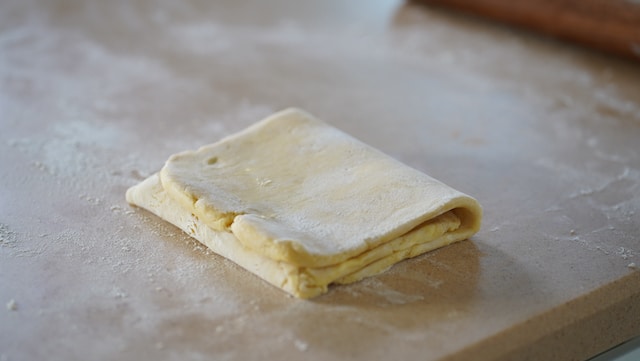Bonjour, my fellow bakers! This is Bruno Albouze, and today we’re diving into the world of puff pastry. Ah, the foundation of iconic dishes like vol-au-vent and mille-feuille! It may seem intimidating, but with a few tips and tricks, you’ll master this culinary art form in no time. There are 3 types of puff pastry. The easiest: Quick puff pastry also known as blitz. Classic puff pastry, and the inverted puff pastry. There are available on my blog. Let’s roll!
The Ingredient List
The quality of your ingredients can make or break your puff pastry. Here’s what you’ll need:
- Flour: Go for all-purpose flour, or one to one ratio all-purpose and bread flour.
- Butter: Just like croissant dough, choose dry butter, which is less moist and richer in fat: 82% minimum.
- Vinegar: A secret ingredient that helps preserve the dough, or more accurately it prevent dough from darkening because of salt.
The Technical Terms
Before you start, there are two terms you should familiarize yourself with:
- Détrempe: This is the initial dough mixture before you start the layering process.
- Tours or Tourage: This refers to the folding and rolling process that creates those beautiful layers. A single “tour” consists of three folds, while a double “tour” consists of four.
The Techniques and Tools
To make puff pastry, you’ll need to master two key techniques:
- Kneading: You can use a stand mixer for speed and convenience, but hand-kneading works just as well. The dough should never be overworked but rather mixed until ingredients are just combined.
- Rolling: This is where you’ll flatten the dough to create layers.
As for tools, you don’t need anything fancy:
- A clean and smooth work surface
- A rolling pin
- Plastic wrap or freezer bag for storing the dough.
Pro Tips for Guaranteed Success
- Quality Ingredient: Always opt for high-quality butter: European-style which must contain 82% fat at least.
- Patience is Key: Allow the dough to rest between each set of folds. This is crucial for achieving those delicate layers.
There you have it—a comprehensive guide to making your own puff pastry. With the right ingredients, techniques, and a little patience, you’ll be on your way to creating mouthwatering desserts and savory delights. As I am often asked if puff pastry can be used in place of croissant dough, I will say: No way. Although puff pastry has some commun similarities with croissant dough, it is radically different mainly due to the yeast involved. Happy baking and bon appétit!

